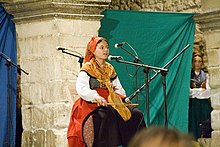Rabel (instrument)
Appearance
 Galician Rabel | |
| String instrument | |
|---|---|
| Classification | String instrument |
| Hornbostel–Sachs classification | (Composite chordophone) |
| Related instruments | |
| Rebec, Rabeca | |

The rabel (or arrabel,[1] robel, rovel[2]) is a bowed stringed instrument from Spain, a rustic folk-fiddle descended from the medieval rebec,[citation needed] with both perhaps descended from the Arab rabab.[3] The instrument generally has two or three strings of gut or steel, or sometimes twisted horse-hair.[4][5] The instrument is first mentioned in the 12th century,[citation needed] and it is still used in parts of Latin America, as well as the Spanish provinces of Cantabria and Asturias.
The rebel is often associates with secular instrumental music, and the most common rabel used in the Middles ages was the soprano.[6]
See also
[edit]References
[edit]- ^ Robert Williams Dale; James Guinness Rogers (1874). The Congregationalist. Hodder and Stoughton. pp. 219–. Retrieved 15 June 2013.
- ^ Stearns Collection of Musical Instruments; Frederick Stearns; Albert Augustus Stanley (1921). Catalogue of the Stearns collection of musical instruments. The University of Michigan. pp. 196–. Retrieved 15 June 2013.
- ^ Luisa Lacál (1899). Diccionario de la música, téchico, histórico, bio-bibliográfico. S.F. de Sales. pp. 428–. Retrieved 15 June 2013.
- ^ Tess Knighton; David Fallows (1992). Companion to Medieval and Renaissance Music. University of California Press. pp. 216–. ISBN 978-0-520-21081-3. Retrieved 15 June 2013.
- ^ Bruno Nettl; Terry Ellis Miller; Sean Williams (1998). The Garland Encyclopedia of World Music: Southeast Asia. Garland Publishing. pp. 991–. ISBN 978-0-8240-6040-4. Retrieved 15 June 2013.
- ^ "Rebec | Musica Antiqua". www.music.iastate.edu. Retrieved 2020-04-26.

